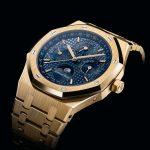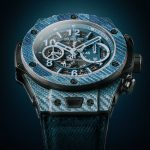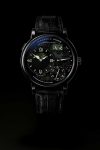Reviews
Design Exchange
What this does for designers – including those who fashion watches – is create grey areas where one may even go so far as shamelessly copying a market leader’s complete look, but it is up to the originator to take legal action. Fortunately, the watch industry doesn’t seem to be too bothered. Either that, or the legal action takes place behind closed doors and we simply don’t hear about it. Take, for example, Rolex’s Oyster bracelet, three links across, older than Madonna and so distinctive that it’s either in the public domain, or Rolex is so justly confident of its identity that it can ignore copyists, of which there are plenty. It’s simply a perfect form for a bracelet – comfortable, durable, adjustable and utterly handsome.
I like to think it’s the latter, that Rolex, ultimately, cares not about brazen stylistic copying, as opposed to actual counterfeiting. Twenty years ago, I saw a friend wearing what I thought was an Air-King. It was made by another brand entirely – a highly respected, mainstream brand which I won’t name – a dress watch almost indistinguishable from a basic Oyster. The case was shallower, but from 2m away, it looked like any steel, non- sport Rolex. And so it goes: you can log on to amazon.co.uk right now and, for £79, buy a watch so brazenly a Submariner lookalike that your inner lawyer is screaming: “Sue them!” But the issue is avoided because the dial has another manufacturer’s name and logo across it. It is not, therefore, being passed off as a Rolex, nor a “sterile” watch, which bears no logo at all. As the saying goes, imitation is the sincerest form of flattery. Think of the watches so precisely designed and configured that any mimicking in their direction would render tumescent even the most impotent solicitor. The Royal Oak clearly inspired the Big Bang, but Hublot uses six bolt heads instead of eight, appearing through a round rather than octagonal bezel.
Side-by-side, you might think: “Naughty Hublot!” But the differences are sufficient to distinguish the two. One might say the same about see-through, cyclonic vacuum cleaners post-Dyson, multi-purpose workbenches post-Black & Decker, or any aviator-style sunglasses following the form of Bausch & Lomb’s original design for Ray-Ban. Watches, despite, having the commonality of needing a means of showing the time, range in look from the classicism and minimalism of a Patek Philippe Calatrava ref. 96 to the near-unreadable science-fiction absurdity of Hautlence, HYT and Cvstos.
Limitless inventiveness has dominated the watch business for the past 30 years, the new wave auteurs stirring it up far more than all of the brands that operated between the beginning of the wristwatch’s ascent after the 1914-1918 war and the watch revival of the mid-1980s. Thumb through any watch price guide history and marvel at how little variety there was prior to the arrival of Messrs Muller, Journe, Roth, Andersen, Preziuso and the others who revived haute horlogerie, paving the way for Urwerk, Greubel Forsey, De Bethune and the second wave of adventurers. They, too, have been copied, but for the most part their reaction has been ambivalent or gentlemanly. For example, within a year or two of Lange & Söhne launching the “big date”, it was everywhere. Lange was probably amused rather than angered, as the brand is exclusive, expensive and who ever decided not to buy a Lange because of someone else’s big date function? Nobody, that’s who. Blue dials, over/under straps, bronze cases: the watch industry is shameless in its me-too-ism and bandwagon-jumping. But let me quote someone I despise, because the idea of stealing words from him, for which I am paid, compensates in some small way for my years of suffering when studying his work at university. Said TS Eliot: “Immature poets imitate; mature poets steal; bad poets deface what they take, and good poets make it into something better, or at least something different.” This was altered by Steve Jobs to describe geniuses, while we can apply it to watch brands borrowing others’ details.
I, for one, prefer to think it’s flattery rather than theft. Unless they copy the logo, too.















